If you want to sharpen your sound design skills, we’d recommend looking at the excellent suite of plugins from Soundtoys. We’re going to do some deep dive sound design on a minimal techno beat.
Most producers who enjoy mixing and sound design will probably already know Soundtoys. The US-based group has steadily found its way into the hearts and minds of producers. It’s easy to see why – they look great, sound great and are some of the best plugins available. At Attack, we have used the Soundtoys plugins on countless Attack pieces over the years.
In this article, we will take you through how to sound design minimal techno with the Soundtoys suite. We’re going to emulate the sound of Robert Hood, Truncate or James Ruskin.
Here’s what we are making today:
N.B We’ve put a full list of where the sounds came from at the bottom of this feature. Some step changes are subtle, it’s sound design after all. Be sure to have a good pair of headphones or monitor speakers.
Let’s get to it! As ever, click on any image to enlarge. If you want to know how we made the sounds to begin with get in touch using the contact form.
Step 1: Kick
Here’s how it sounds dry:
Little Plate adds ambience reminiscent of the dimension expander found in NI Massive. Set the DECAY to the shortest setting, 0.5 seconds and LOW CUT at 140Hz. On the MIX, dial in 5% on the DRY/WET parameter. This ensures that the reverb is very slight and doesn’t muddy the intense low-end punch of the kick.

Next, load up Radiator. We’re going to use it as a subtle parallel tone shaper. Select the MIC option for its characteristic frequency response. Notice how it includes much more noise than the LINE option. Flip the NOISY/CLEAN switch to CLEAN to kill that added effect.
Since the kick sample didn’t have much in the high frequency to begin with, we leave the TREBLE. We dial in a little space using the BASS knob.
We’ve also added 3dB to the OUTPUT for a little analogue saturation. Lastly, reduce the overall MIX by about 50% to ensure a balanced blend.

Step 2: Bass
Here’s how it sounds dry:
N.B We will condense our description here to the most interesting points since there is quite a lot to talk about in a stacked rack of devices.
Stage 1: Saturation
Set Decapitator to the P STYLE which emulates the Thermionic Culture ‘Culture Vulture‘. This generates odd harmonics in the signal providing a colder style saturation. The DRIVE setting is halfway at 5 providing plenty of excitement in the high end.
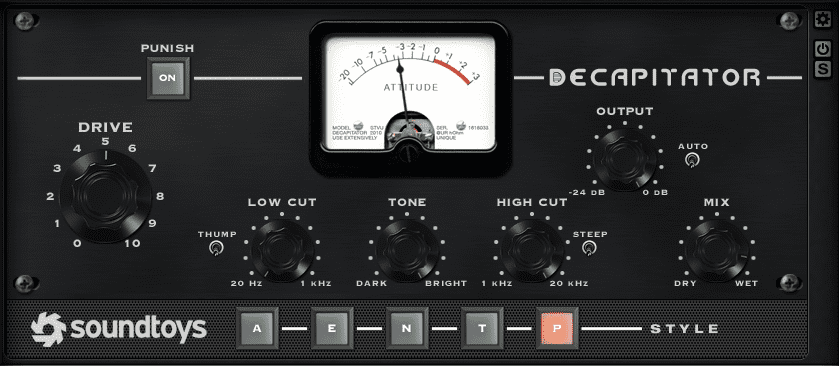
Stage 2: High Boost
The Sie-Q is great for boosting high end so we hop to it and give the sound +15dB on the high shelf, +4dB on the mid-range centred around 3.5kHz and -3dB on the low shelf. We don’t apply further drive here.

Stage 3: Tone and Boost
Having successfully highlighted the clicks in the 16th note sequence, we opt for a final high boost using the Radiator. This time we apply a NOISY MIC and a further +3dB on the TREBLE control.

Stage 4: Subtle Echo
Let’s use EchoBoy to finish it off. Apply the 70s/80s style Analog Delay at just 10% strength for a very subtle effect.
The 1/8th delay fades quickly at the 0.25 FEEDBACK and a LOW CUT at 0.50 ensures an unobstructed low end.
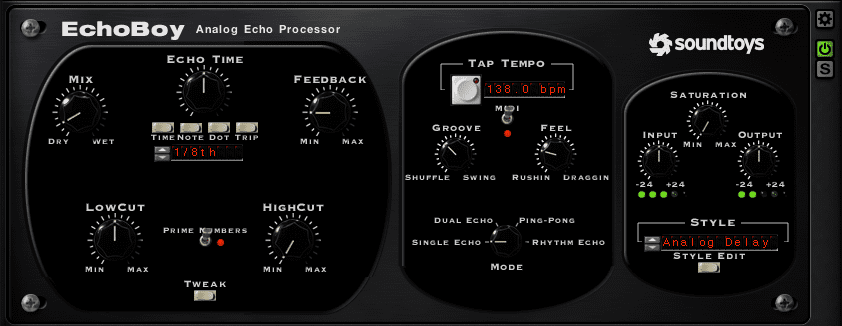
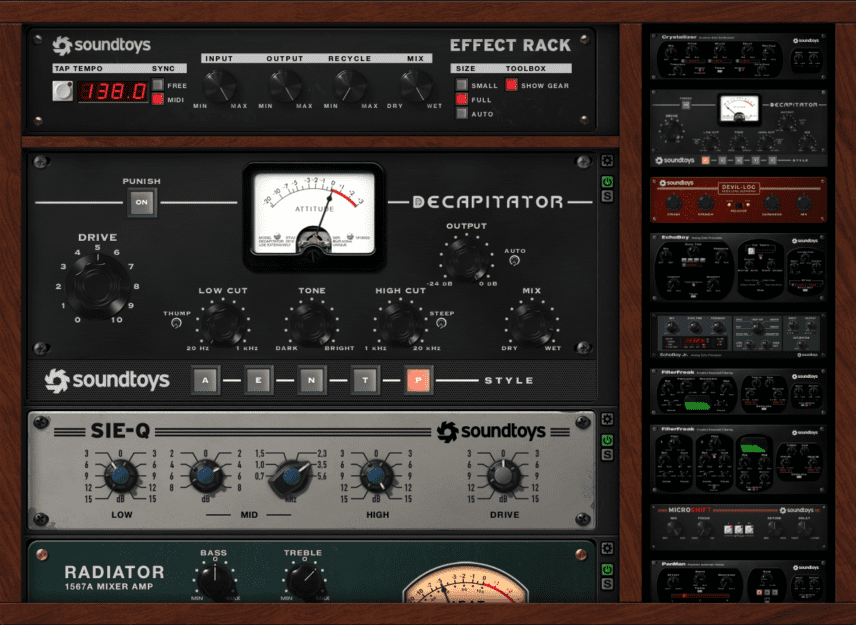
Step 3: Percussion Group
Here’s how it sounds dry:
We bring up the EMT140 Plate emulation again. In its natural range, it maxes around 5 seconds.
We use a 2 second DECAY time with MOD enabled. This means that there are subtle variations that lead to a slightly smoother sound at longer decay times. Wicked…!
Move the LOW CUT control to 140Hz. It makes sure the reverb does not interfere with the low end in the percussion. A DRY/MIX setting of 10% seems appropriate here. As ever, dial in to taste! Get creative!

Step 4: Lead
Here’s how it sounds dry:
Stage 1: Tonal Shaping
Working opposite to the bass we utilise Sie-Q to shave 9dB off the top using the HIGH control. We exaggerate 700Hz in the body of the sound with an 8dB boost to the MID. Remove 6dB is from the low end using the LOW control to compensate for the mid gain.
This processing shifts the focus of the sound more to the mid-range of the mix.

Stage 2: Sci-Fi Delay
The modulating fast delay times evoke a certain 80s sci-fi feel! This heavily influenced the early Detroit techno pioneers.
To achieve this stereo effect, short delay times of 0.25 and 0.50 beats are used for the left (red knob A) and (right knob B) respectively.
A 10% FEEDBACK for the right (red slider) and 30% feedback for the left (yellow slider) creates a slightly uneven movement which creates a little more interest.
At 12-o-clock on the dials, a modulation RATE of 5.622Hz and modulation DEPTH of 0.033 creates a warble in the pitch with further enhances the aesthetic.

Stage 3: Pan Override
The stereo sound is fairly intense so it’s interesting to see what effect the PanMan has on the signal.
The panner is set to a 1/2 Note speed on the RHYTHM SHAPE which resembles the movement of a sawtooth wave. This sawtooth motion is especially evident when no SMOOTHING is applied. Therefore, we take the WIDTH to approximately 100 degrees at the 12-o-clock setting to reduce the range of motion. We don’t want the effect of the panning to override the stereo delay entirely.

Stage 4: Crush & Crunch
Devil-Loc Deluxe is an interesting way to create breathy compression effects on signals, and in this case it works wonders on the sci-fi delay tails!
A healthy CRUNCH setting of 8.0 creates a decent yet rough focus on the delays which emerge after the strong notes in the sequence.
We really want to see how this 60s consumer grade limiting amplifier pushes the dynamics around. The FAST RELEASE ensures a focus on the compression pump. We have also maxed out the DARKNESS control to hide those saturated artefacts.
To gain a little brightness back the MIX is set to 50% for a parallel treatment.

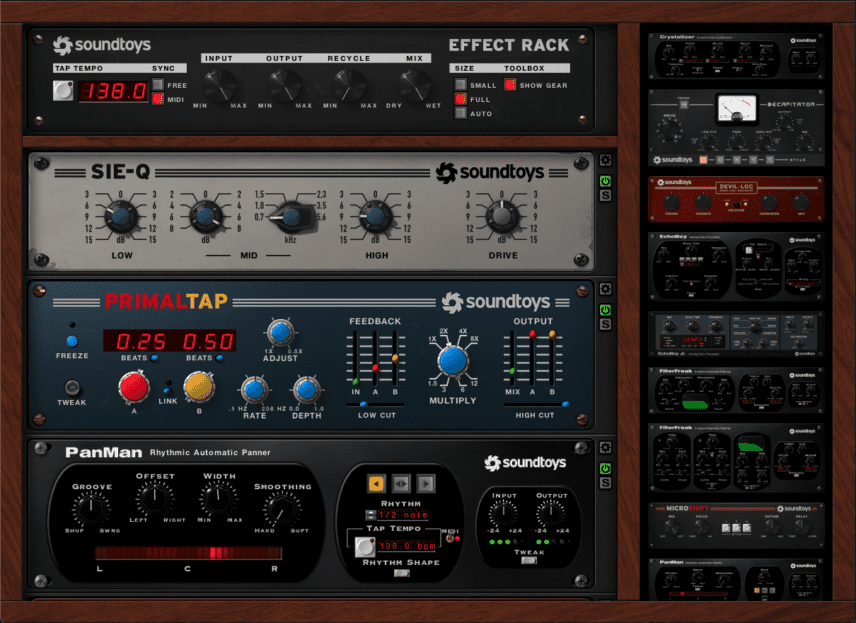
Step 5: Drone
Here’s how it sounds dry:
Stage 1: Shimmering Delay
The H3000 was famous for its pitch shifting and reverse echo effects.
The PITCH parameter is turned so that the cents readout is at 1200, meaning we get our delays back at one octave higher than the original signal.
The delays aren’t reversed since for a constant tone such as this it’s not very obvious. We set the RECYCLE (feedback) control at 0.250 which equates to 25% and set the overall MIX at 20% so that the effect is noticeable without being overbearing.
Note: The Crystallizer is one huge amount of fun. Really mess about with it. You’ll enjoy it..!

Stage 2: Formant Shift
Little AlterBoy is used to shift the FORMANT content down to -12. This gives our drone a thicker tone and feels like adding a sub oscillator to the tone.
Interestingly, the click at the beginning of the source loop is caught by the algorithm and glitched in a unique quirky way with each pass. The MIX is set to 50% to give the sound plenty of body.

Step 6: Vocals
Of the Repeat, Select, Control and Distort, two words were specifically chosen for demonstration purposes.
Stage 1: “Repeat” Vocal Phrase
Here’s how it sounds dry:
EchoBoy was chosen this time on its Splattered algorithm which the manual states is a “Highly reflective reverb effect.”
On the SINGLE ECHO MODE and 1/2 note ECHO TIME the steadily fading cluster of reverberated tight delay groups fades steadily into the distance. It’s poetic…!
Choosing a FEEDBACK time of 0.50 ensures that the delays are cleared by the time the vocal sounds again in the loop.
The delay clusters are reminiscent of first reflections in rooms that are made of highly reflective surfaces such as glass or polished metal.
Each delay also modulates creating phase like effects in each cluster.
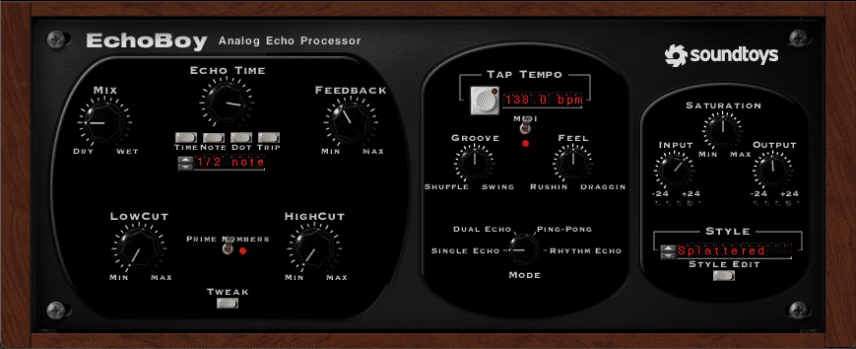
Stage 2: “Distort” Vocal Phrase
Here’s how it sounds dry:
The Devil-Loc is a quick way to create pleasing distortion effects.
Compression is maxed at 10 using the CRUSH control and CRUNCH raised to 5 to ensure that the distortion is clearly audible in the mix when all other elements are in play.
FINAL
Put all the above together and we have this minimal techno beauty:
For more information on Soundtoys check out their website. They are currently offering a huge sale of up to 70% for Black Friday.
SOUNDS USED
- Kick: Selector Kit Producer (kick #4)
- Tom: Wing Tip Kit.
- Bass: Operator custom patch, automation on filter resonance, EQ Eight controlling bass and adding resonances with modulation by max for live LFO.
- Perc: Selector Kit Clean – Hat #63, Clap #8, Perc #48. Perc sidechined to main kick, EQ Eight controlling bass, Glue Compressor bringing all sounds together.
- Lead: Operator custom patch
- Drone: Audio File – Sourced from pack “Hypermorph by Sonic Faction” under the “Osc” category. File – Pulse_Sweep_Overdrive+Distortion-127-124-127-0-OOOR
- Vocal: Text to Talk
*Attack Magazine is supported by its audience. When you purchase through links on our site, we may earn an affiliate commission. Learn more.

